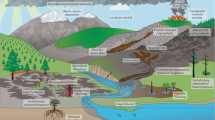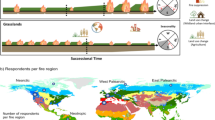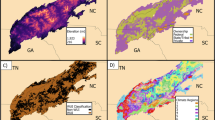Abstract
Purpose of Review
I sought to review the contributions of recent literature and prior foundational papers to our understanding of drought and fire. In this review, I summarize recent literature on drought and fire in the western USA and discuss research directions that may increase the utility of that body of work for twenty-first century application. I then describe gaps in the synthetic knowledge of drought-driven fire in managed ecosystems and use concepts from use-inspired research to describe potentially useful extensions of current work.
Recent Findings
Fire responses to climate, and specifically various kinds of drought, are clear, but vary widely with fuel responses to surplus water and drought at different timescales. Ecological and physical factors interact with human management and ignitions to create fire regime and landscape trajectories that challenge prediction.
Summary
The mechanisms by which the climate system affects regional droughts and how they translate to fire in the western USA need more attention to accelerate both forecasting and adaptation. However, projections of future fire activity under climate change will require integrated advances on both fronts to achieve decision-relevant modeling. Concepts from transdisciplinary research and coupled human-natural systems can help frame strategic work to address fire in a changing world.

Similar content being viewed by others
References
Papers of particular interest, published recently, have been highlighted as: • Of importance •• Of major Importance
• Moritz MA, Batllori E, Bradstock RA, Gill AM, Handmer J, Hessburg PF, et al. Learning to coexist with wildfire. Nature. 2014;515:58–66. https://doi.org/10.1038/nature13946. This paper highlights and substantiates the idea that wildland fire cannot be managed independently of its context as a social ecological system.
Lee C, Schlemme C, Murray J, Unsworth R. The cost of climate change: ecosystem services and wildland fires. Ecol Econ. 2015;116:261–9. https://doi.org/10.1016/J.ECOLECON.2015.04.020.
Ager AA, Barros AMG, Preisler HK, Day MA, Spies TA, Bailey JD, et al. Effects of accelerated wildfire on future fire regimes and implications for the United States federal fire policy. Ecol Soc. 2017;22:art12. https://doi.org/10.5751/ES-09680-220412.
Bowman DMJS, Balch JK, Artaxo P, Bond WJ, Carlson JM, Cochrane MA, et al. Fire in the Earth System. Science (80- ). 2009;324:481–4. https://doi.org/10.1126/science.1163886.
Flannigan MD, Krawchuk MA, de Groot WJ, Wotton BM, Gowman LM. Implications of changing climate for global wildland fire. Int J Wildl Fire. 2009;18:483. https://doi.org/10.1071/WF08187.
•• McKenzie D, Littell JS. Climate change and the eco-hydrology of fire: will area burned increase in a warming western USA. Ecol Appl. 2017;27:26–36. https://doi.org/10.1002/eap.1420. This paper underscores the non-stationarity in climate-fire relationships in the American West and shows that fuel- and flammability-limited systems may exhibit a wide range of behavior under climate change. It further argues that statistical climate-fire relationships are likely to be of limited use in a no-analog future.
•• Schoennagel T, Balch JK, Brenkert-Smith H, Dennison PE, Harvey BJ, Krawchuk MA, et al. Adapt to more wildfire in western North American forests as climate changes. Proc Natl Acad Sci U S A. 2017;114:4582–90. https://doi.org/10.1073/pnas.1617464114. This paper lays out the dimensions of problems confronted by people given current and future wildfire, and underscores the need for deliberate adaptation.
Fu Q, Feng S. Responses of terrestrial aridity to global warming. J Geophys Res Atmos. 2014;119:7863–75. https://doi.org/10.1002/2014JD021608.
Chapin FS, Trainor SF, Huntington O, Lovecraft AL, Zavaleta E, Natcher DC, et al. Increasing wildfire in Alaska’s boreal Forest: pathways to potential solutions of a wicked problem. Bioscience. 2008;58:531–40. https://doi.org/10.1641/B580609.
Bowman DMJS, Murphy BP, Williamson GJ, Cochrane MA. Pyrogeographic models, feedbacks and the future of global fire regimes. Glob Ecol Biogeogr. 2014;23:821–4. https://doi.org/10.1111/geb.12180.
• Fischer AP, Spies TA, Steelman TA, Moseley C, Johnson BR, Bailey JD, et al. Wildfire risk as a socioecological pathology. Front Ecol Environ. 2016;14:276–84. https://doi.org/10.1002/fee.1283. This paper refines the description of fire social-ecological systems and substantiates the case that fire is a coupled human-natural system.
O’Connor CD, Garfin GM, Falk DA, Swetnam TW. Human pyrogeography: a new synergy of fire, climate and people is reshaping ecosystems across the globe. Geogr Compass. 2011;5:329–50. https://doi.org/10.1111/j.1749-8198.2011.00428.x.
• DMJS B, Garnett ST, Barlow S, Bekessy SA, Bellairs SM, Bishop MJ, et al. Renewal ecology: conservation for the Anthropocene. Restor Ecol. 2017;25:674–80. https://doi.org/10.1111/rec.12560. This paper provides one conceptual framework for thinking about coupled human natural systems, especially ways in which fire can be embraced rather than managed by suppression.
Pohl C, Hirsch Hadorn G. Principles for designing transdisciplinary research: proposed by the Swiss Academies of Arts and Sciences. München: oekom Verlag; 2007.
Pohl C, Hirsch Hadorn G. Methodological challenges of transdisciplinary research. Nat Sci Soc. 2008;16:111–21. https://doi.org/10.1051/nss:2008035.
Keane RE, Ryan KC, Veblen TT, Allen CD, Logan J, Hawkes B. Cascading effects of fire exclusion in the Rocky Mountain ecosystems: a literature review. In: General Technical Report. RMRS-GTR-91. Fort Collins, CO: U.S. Department of Agriculture, Forest Service, Rocky Mountain Research Station. 24 p. (Vol. 91); 2002. https://doi.org/10.2737/RMRS-GTR-91.
Miller C. The hidden consequences of fire suppression. Park Science. 2012; 28(3). Online: http://www.nature.nps.gov/ParkScience/index.cfm?ArticleID=547&Page=1 . Retrieved from https://www.fs.usda.gov/treesearch/pubs/40395
• Kitzberger T, Falk DA, Westerling AL, Swetnam TW. Direct and indirect climate controls predict heterogeneous early-mid 21st century wildfire burned area across western and boreal North America. PLoS One. 2017;12:e0188486. https://doi.org/10.1371/journal.pone.0188486. This paper describes both human and climatic contributions to fire, and describes further the hazards of projecting statistical climate-fire relationships
•• Crausbay SD, Ramirez AR, Carter SL, Cross MS, Hall KR, Bathke DJ, et al. Defining ecological drought for the twenty-first century. Bull Am Meteorol Soc. 2017;98:2543–50. https://doi.org/10.1175/BAMS-D-16-0292.1. This paper expands the definition of drought to include ecological drought and its human dimensions.
• Littell JS, Peterson DL, Riley KL, Liu Y, Luce CH. A review of the relationships between drought and forest fire in the United States. Glob Chang Biol. 2016;22:2353–69. This paper reviews application of physical, hydrologic, and ecohydrological drought mechanisms in fire research in the US.
Dai A. Characteristics and trends in various forms of the palmer drought severity index during 1900–2008. J Geophys Res. 2011;116:D12115. https://doi.org/10.1029/2010JD015541.
Westerling AL, Gershunov A, Brown TJ, Cayan DR, Dettinger MD, Westerling AL, et al. Climate and wildfire in the western United States. Bull Am Meteorol Soc. 2003;84:595–604. https://doi.org/10.1175/BAMS-84-5-595.
Littell JS, Oneil EE, McKenzie D, Hicke JA, Lutz JA, Norheim RA, et al. Forest ecosystems, disturbance, and climatic change in Washington state, USA. Clim Chang. 2010;102:129–58. https://doi.org/10.1007/s10584-010-9858-x.
Littell JS, Gwozdz RB (2011) Climatic water balance and regional fire years in the Pacific Northwest, USA: linking regional climate and fire at landscape scales. pp 117–139 in McKenzie, D C. Miller, and D.A. Falk, eds. The landscape ecology of fire, Dordrecht Springer Ltd.
McKenzie D, Littell JS. Climate change and wilderness fire regimes. Int J Wilderness. 2011;17:22–31.
Abatzoglou JT, Kolden CA. Relationships between climate and macroscale area burned in the western United States. Int J Wildl Fire. 2013;22:1003–20. https://doi.org/10.1071/WF13019.
Sherwood S, Fu Q. A Drier future? Science. 2014;343(6172):737–9. https://doi.org/10.1126/science.1247620.
Breshears DD, Cobb NS, Rich PM, Price KP, Allen CD, Balice RG, et al. Regional vegetation die-off in response to global-change-type drought. Proc Natl Acad Sci. 2005;102:15144–8. https://doi.org/10.1073/pnas.0505734102.
Mo KC, Lettenmaier DP. Precipitation deficit flash droughts over the United States. J Hydrometeorol. 2016;17:1169–84. https://doi.org/10.1175/JHM-D-15-0158.1.
Williams AP, Seager R, Berkelhammer M, Macalady AK, Crimmins MA, Swetnam TW, et al. Causes and implications of extreme atmospheric moisture demand during the record-breaking 2011 wildfire season in the Southwestern United States. J App Met Clim. 2014;53:2671–84. https://doi.org/10.1175/JAMC-D-14-0053.1.
Marlier ME, Xiao M, Engel R, Livneh B, Abatzoglou JT, Lettenmaier DP. The 2015 drought in Washington state: a harbinger of things to come? Environ Res Lett. 2017;12:114008. https://doi.org/10.1088/1748-9326/aa8fde.
• Harpold AA, Dettinger M, Rajagopal S. Defining snow drought and why it matters. Eos. 2017;98 https://doi.org/10.1029/2017EO068775. This paper clarifies terminology used for some time and distinguishes snow drought from – and relates it to other forms of drought.
Westerling AL, Hidalgo HG, Cayan DR, Swetnam TW. Warming and earlier spring increase western U.S. forest wildfire activity. Science. 2006;313:940–3. https://doi.org/10.1126/science.1128834.
Westerling AL. Increasing western US forest wildfire activity: sensitivity to changes in the timing of spring. Philos Trans R Soc Lond Ser B Biol Sci. 2016;371:20150178. https://doi.org/10.1098/rstb.2015.0178.
Gergel DR, Nijssen B, Abatzoglou JT, Lettenmaier DP, Stumbaugh MR. Effects of climate change on snowpack and fire potential in the western USA. Clim Chang. 2017;141:287–99. https://doi.org/10.1007/s10584-017-1899-y.
Holden ZA, Luce CH, Crimmins MA, Morgan P. Wildfire extent and severity correlated with annual streamflow distribution and timing in the Pacific Northwest, USA (1984-2005). Ecohydrology. 2012;5:677–84. https://doi.org/10.1002/eco.257.
Williams AP, Abatzoglou JT. Recent advances and remaining uncertainties in resolving past and future climate effects on global fire activity. Curr Clim Chang Rep. 2016;2:1–14. https://doi.org/10.1007/s40641-016-0031-0.
van der Werf GR, Randerson JT, Giglio L, Gobron N, Dolman AJ. Climate controls on the variability of fires in the tropics and subtropics. Global Biogeochem Cycles. 2008;22:n/a-n/a. https://doi.org/10.1029/2007GB003122.
Schroeder MJ. Critical fire weather patterns in the conterminous United States. Silver Spring, MD: Environmental Science Services Administration; 1969.
Potter BE. Atmospheric interactions with wildland fire behaviour - I. Basic surface interactions, vertical profiles and synoptic structures. Int J Wildl Fire. 2012;21:779. https://doi.org/10.1071/WF11128.
Johnson EA, Wowchuk DR. Wildfires in the southern Canadian Rocky Mountains and their relationship to mid-tropospheric anomalies. Can J For Res. 1993;23:1213–22. https://doi.org/10.1139/x93-153.
Skinner WR, Stocks BJ, Martell DL, Bonsal B, Shabbar A. The association between circulation anomalies in the mid-troposphere and area burned by wildland fire in Canada. Theor Appl Climatol. 1999;63:89–105. https://doi.org/10.1007/s007040050095.
Gedalof Z, Peterson DL, Mantua NJ. Atmospheric, climatic, and ecological controls on extreme wildfire years in the northwestern United States. Ecol Appl. 2005;15:154–74. https://doi.org/10.1890/03-5116.
Crimmins MA. Synoptic climatology of extreme fire-weather conditions across the southwest United States. Int J Climatol. 2006;26:1001–16. https://doi.org/10.1002/joc.1300.
Trouet V, Taylor AH, Carleton AM, Skinner CN. Interannual variations in fire weather, fire extent, and synoptic-scale circulation patterns in northern California and Oregon. Theor Appl Climatol. 2009;95:349–60. https://doi.org/10.1007/s00704-008-0012-x.
Hostetler SW, Bartlein PJ, Holman JO. Atlas of climatic controls of wildfire in the Western United States. U.S. Geological Survey Scientific Investigations Report 5139. 2006; 67 p.
Diaz HF, Swetnam TW. The wildfires of 1910: climatology of an extreme early twentieth-century event and comparison with more recent extremes. Bull Am Meteorol Soc. 2013;94:1361–70. https://doi.org/10.1175/BAMS-D-12-00150.1.
Riley KL, Abatzoglou JT, Grenfell IC, Klene AE, Heinsch FA. The relationship of large fire occurrence with drought and fire danger indices in the western USA, 1984-2008: the role of temporal scale. Int J Wildl Fire. 2013;22:894–909. https://doi.org/10.1071/WF12149.
Collins BM, Omi PN, Chapman PL. Regional relationships between climate and wildfire-burned area in the Interior West, USA. Can J For Res. 2006;36:699–709. https://doi.org/10.1139/x05-264.
McKenzie D, Gedalof Z, Peterson DL, Mote P. Climatic change, wildfire, and conservation. Conserv Biol. 2004;18:890–902.
Littell JS, Mckenzie D, Peterson DL, Westerling AL. Climate and wildfire area burned in western U.S. ecoprovinces, 1916-2003. Ecol Appl. 2009;19:1003–21. https://doi.org/10.1890/07-1183.1.
• Keeley JE, Syphard AD. Different historical fire–climate patterns in California. Int J Wildl Fire. 2017;26:253. https://doi.org/10.1071/WF16102. This paper illustrates both the differences in climate-fire relationships across vegetation types but also the role of fire management in potentially affecting the ways climate and fire interact.
Swetnam TW. Fire history and climate change in giant sequoia groves. Science. 1993;262:885–9.
Swetnam TW, Betancourt JL. Fire-southern oscillation relations in the southwestern United States. Science. 1990;249:1017–20. https://doi.org/10.1126/science.249.4972.1017.
Swetnam TW, Betancourt JL. Mesoscale disturbance and ecological response to decadal climatic variability in the American Southwest. J Clim. 1998;11:3128–47. https://doi.org/10.1175/1520-0442(1998)011<3128:MDAERT>2.0.CO;2.
Heyerdahl EK, Brubaker LB, Agee JK. Annual and decadal climate forcing of historical fire regimes in the interior Pacific Northwest, USA. The Holocene. 2002;12:597–604. https://doi.org/10.1191/0959683602hl570rp.
Hessl AE, McKenzie D, Schellhaas R. Drought and pacific decadal oscillation linked to fire occurrence in the inland pacific northwest. Ecol Appl. 2004;14:425–42. https://doi.org/10.1890/03-5019.
Gavin DG, Hallett DJ, Hu FS, Lertzman KP, Prichard SJ, Brown KJ, et al. Forest fire and climate change in western North America: insights from sediment charcoal records. Front Ecol Environ. 2007;5:499–506. https://doi.org/10.1890/060161.
Heyerdahl EK, McKenzie D, Daniels LD, Hessl AE, Littell JS, Mantua NJ. Climate drivers of regionally synchronous fires in the inland Northwest (16511900). Int J Wildl Fire. 2008;17:40–9. https://doi.org/10.1071/WF07024.
Margolis EQ, Woodhouse CA, Swetnam TW. Drought, multi-seasonal climate, and wildfire in northern New Mexico. Clim Chang. 2017;142:433–46. https://doi.org/10.1007/s10584-017-1958-4.
Schoennagel T, Veblen TT, Romme WH, Sibold JS, Cook ER. ENSO and PDO variability affect drought-induced fire occurrence in Rocky Mountain subalpine forests. Ecol Appl. 2000;15:2000–14.
Dettinger MD, Cayan DR, Diaz HF, Meko DM. North–south precipitation patterns in Western North America on interannual-to-decadal timescales. J Clim. 1998;11:3095–111. https://doi.org/10.1175/1520-0442(1998)011<3095:NSPPIW>2.0.CO;2.
McCabe GJ, Palecki MA, Betancourt JL. Pacific and Atlantic Ocean influences on multidecadal drought frequency in the United States. Proc Natl Acad Sci U S A. 2004;101:4136–41. https://doi.org/10.1073/pnas.0306738101.
Marlon JR, Bartlein PJ, Gavin DG, Long CJ, Anderson RS, Briles CE, et al. Long-term perspective on wildfires in the western USA. Proc Natl Acad Sci U S A. 2012;109:E535–43. https://doi.org/10.1073/pnas.1112839109.
Simard AJ, Haines DA, Main WA. Relations between El Nino/Southern Oscillation anomalies and wildland fire activity in the United States. Agric For Meteorol. 1985;36(2):93–104. https://doi.org/10.1016/0168-1923(85)90001-2.
Kitzberger T, Brown PM, Heyerdahl EK, Swetnam TW, Veblen TT. Contingent Pacific-Atlantic Ocean influence on multicentury wildfire synchrony over western North America. Proc Natl Acad Sci U S A. 2007;104:543–8. https://doi.org/10.1073/pnas.0606078104.
Gedalof Z. Climate and spatial patterns of wildfire in North America. In: McKenzie D, Miller C, Falk D, editors. The landscape ecology of fire. Ecological Studies (Analysis and Synthesis). Dordrecht: Springer; 2011.
Crimmins MA. Interannual to decadal changes in extreme fire weather event frequencies across the southwestern United States. Int J Climatol Int J Clim. 2011;31:1573–83. https://doi.org/10.1002/joc.2184.
Mason SA, Hamlington PE, Hamlington BD, Matt Jolly W, Hoffman CM. Effects of climate oscillations on wildland fire potential in the continental United States. Geophys Res Lett. 2017;44:7002–10. https://doi.org/10.1002/2017GL074111.
Schubert SD, Stewart RE, Wang H, Barlow M, Berbery EH, Cai W, et al. Global meteorological drought: a synthesis of current understanding with a focus on SST drivers of precipitation deficits. J Clim. 2016;29:3989–4019.
• McAfee SA, McAfee SA. Consistency and the lack thereof in Pacific Decadal Oscillation impacts on North American winter climate. J Clim. 2014;27:7410–31. https://doi.org/10.1175/JCLI-D-14-00143.1. This paper questions the stationarity of the PDO influence on North American climatology and presents evidence that its predictive capacity is limited for impacts.
Barbero R, Abatzoglou JT, Brown TJ. Seasonal reversal of the influence of El Niño-Southern Oscillation on very large wildfire occurrence in the interior northwestern United States. Geophys Res Lett. 2015;42:3538–45. https://doi.org/10.1002/2015GL063428.
Jolly WM, Cochrane MA, Freeborn PH, Holden ZA, Brown TJ, Williamson GJ, et al. Climate-induced variations in global wildfire danger from 1979 to 2013. Nat Commun. 2015;6:6. https://doi.org/10.1038/ncomms8537.
•• Abatzoglou JT, Williams AP. Impact of anthropogenic climate change on wildfire across western US forests. Proc Natl Acad Sci. 2016;113:11770–5. https://doi.org/10.1073/pnas.1607171113. This paper is the first quantitative climate change attribution study for forest fire – it assesses the relative contribution of anthropogenic climate change and climatic variability in the recent fire history.
Hostetler SW, Bartlein PJ, Alder JR. Atmospheric and surface climate associated with 1986-2013 wildfires in North America. J Geophys Res Biogeosci. 2018;123:1588–609. https://doi.org/10.1029/2017JG004195.
Nicolai-Shaw N, Gudmundsson L, Hirschi M, Seneviratne SI. Long-term predictability of soil moisture dynamics at the global scale: persistence versus large-scale drivers. Geophys Res Lett. 2016;43:8554–62. https://doi.org/10.1002/2016GL069847.
Seager R, Ting M. Decadal drought variability over North America: mechanisms and predictability. Curr Clim Chang Rep. 2017;3:141–9. https://doi.org/10.1007/s40641-017-0062-1.
Owen G, Mcleod JD, Kolden CA, Ferguson DB, Brown TJ Wildfire management and forecasting fire potential: the roles of climate information and social networks in the Southwest United States. 2012; https://doi.org/10.1175/WCAS-D-11-00038.1,.
Higuera PE, Abatzoglou JT, Littell JS, Morgan P. The changing strength and nature of fire-climate relationships in the northern Rocky Mountains, U.S.A., 1902-2008. PLoS One. 2015:10. https://doi.org/10.1371/journal.pone.0127563.
Holling CS, Gunderson LH. Chapter 2: Resilience and adaptive cycles. In: Gunderson LH, Holling CS, editors. Panarchy : understanding transformations in human and natural systems. Washington, D.C.: Island Press; 2002.
Fath BD, Dean CA, Katzmair H. Navigating the adaptive cycle: an approach to managing the resilience of social systems. Ecol Soc. 2015;20:art24. https://doi.org/10.5751/ES-07467-200224.
Littell JS, Peterson DL, Millar CI, O’Halloran KA. U.S. National Forests adapt to climate change through science–management partnerships. Clim Chang. 2012;110:269–96. https://doi.org/10.1007/s10584-011-0066-0.
Holling CS. Resilience and stability of ecological systems. Annu Rev Ecol Syst. 1973;4:1–23. https://doi.org/10.1146/annurev.es.04.110173.000245.
Doane DL, O’Laughlin J, Morgan P, Miller C. Barriers to wildland fire use: a preliminary problem analysis. Int J Wilderness. 2006;12(1):36–8.
Acknowledgements
I thank three anonymous reviewers for constructive comments on earlier drafts of the manuscript.
Funding
This work was funded by the Department of Interior Alaska Climate Adaptation Science Center. Any use of trade, firm, or product names is for descriptive purposes only and does not imply endorsement by the US Government.
Author information
Authors and Affiliations
Corresponding author
Ethics declarations
Conflict of Interest
Corresponding author states there is no conflict of interest.
Additional information
This article is part of the Topical Collection on Climate Change and Drought
Rights and permissions
About this article
Cite this article
Littell, J.S. Drought and Fire in the Western USA: Is Climate Attribution Enough?. Curr Clim Change Rep 4, 396–406 (2018). https://doi.org/10.1007/s40641-018-0109-y
Published:
Issue Date:
DOI: https://doi.org/10.1007/s40641-018-0109-y




